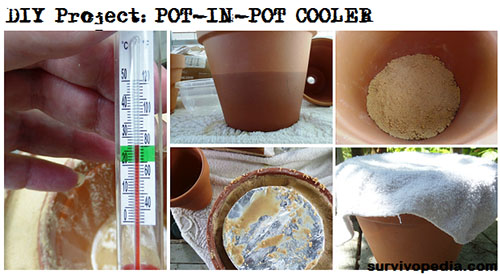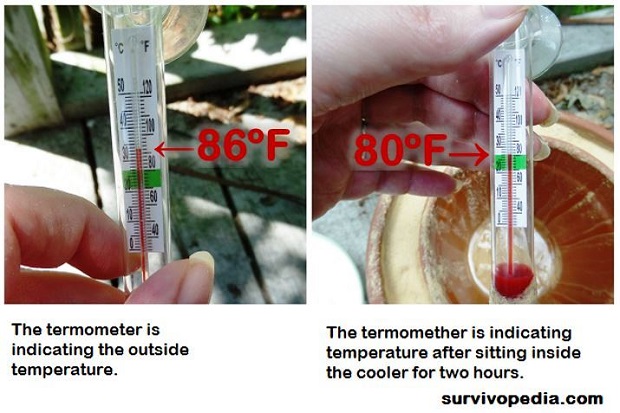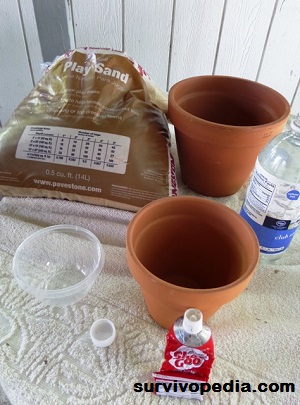As temperatures warm up, there is a natural tendency to look for ways to keep outdoor lunches cool, or even store other items without spending a fortune on ice and plastic chests.


The flower pot cooler is easy to build, easy to use, and will never wear out.
When placed in a sunny location, it will produce a minimum of 10 degrees reduction in temperature, and as much as 30 degrees lower on a hot, dry day. With the addition of a fan, this device can produce even lower temperatures that will enable you to store perishable items.
How and Why it Works
The flower pot cooler uses an inner terra cotta pot surrounded by sand and an outer terra cotta pot. As water evaporates from the sand, it leaches into the outer pot more than the inner one, thus creating a wicking action.
As humidity is pulled from the sand and the inner pot, the temperature inside the inner pot cools down.
Overall, the cooler the inner pot is in relation to the outer temperature, the faster the water will evaporate. This also tends to lead to accelerated cooling across time instead of simple steady decline in temperature. Interestingly enough, this type of evaporation is similar to the way refrigerators and air conditioners work.
The only difference is they use higher temperatures, motorized fans, and other materials to create a cooling effect.


DIY Project: The Easiest Off-grid Fridge
Tools and Parts:
Required Tools: small cup or laddle for sand

Required Parts:
- 1 – 8“ unglazed terra cotta flower pot (approx $3.50)
- 1 – 6“ unglazed terra cotta flower pot (approx $2.50)
- Approx 3 – 4 pounds of sand (approx 4.00 for 20+ pounds)
- 1 quart of water (less than $1.00)
- 2 bottle caps or something else waterproof to cover holes in bottom of terra cotta pots (less than $1.00)
- Shoe Goo or other water proof glue that can bind clay to plastic (approx $3.00 to $5.00 depending on brand and tube size)
- Saucer or plate to cover inner pot ($1.00 or less)
- White towel to cover plate ($1.00 or less)
Building the Flower Pot Cooler
Turn the flower pot upside down and add additional sealant to completely fill the hole. This will help prevent leaks.
Repeat the same procedure with a second bottle cap for the 6“ flower pot. Let both pots dry a minimum of 24 hours before proceeding to the next step.
Step 2: Place enough sand in the bottom of the 8“ flower pot so that the lip of the 6“ flower pot is even with the 8“ flower pot.
Step 3: Once you have enough sand packed into the 8“ flower pot, add water to the sand. You will see some bubbles as air is pushed out of the sand.
Let the flower pot sit for a few hours and check for leaks.
Water will begin seeping into the pots and turn them a darker color.
When operating the flower pot cooler, it should start with the darker color so that you know enough water is in place for effective evaporation.
Step 4: After the water has had a chance to disburse through the sand, place the 6“ flower pot inside the 8“ one.
Cover the inner pot with a saucer or tin foil so that sand and water cannot get into the inner chamber.
Once you reach the top, leave approximately one inch below the top of the pots so that you have a small channel for adding water later on.
If built correctly, you will not need to disassemble the cooler to stir up the sand or make it more permeable to the water.
Operating the Flower Pot Cooler
You can use the flower pot cooler as long as the sand is moist. Simply place whatever needs to be kept cool in a water proof bag and then put that in the 6“ flower pot.
Next, cover the inner flower pot with a saucer, and then place a white towel on top of that.
White will deflect heat, and thus keep the inner chamber a bit cooler without preventing the sides of the outer flower part from being exposed to as much heat as possible.
Notes for Future Development
Here are some ideas that may make your flower pot cooler more effective, and also enable you to transform the basic concepts into a permanent outdoor cooler that harnesses solar power for cooling.
- Try using an ice cube inside the inner chamber of the flower pot cooler because it will create a difference between internal and external temperatures faster. I do not recommend using cool water to moisten the sand because that will slow down evaporation rates; however warm water might accelerate the process.
- Use two wooden boxes and sand between them, or sponges for holding the water. Other highly porous materials might also work for building larger, permanent outdoor coolers
- When using a fan with the flower pot cooler, do not aim the fan into the pots, instead let the air hit the sides of the pot. While it is possible to build a cooling system with a fan aimed into a bucket, clay or wooden walls will not allow the air to diffuse effectively. In addition, the cool air will be blown out of the inner pot, which results in the loss of a cooling chamber.
This article has been written by Carmela Tyrell for Survivopedia.
Want to be as self-sufficient as possible? Want to master all the lost skills our grandfathers had?
Then you really need this amazing step-by-step guide. It is called The Lost Ways and it contains all the knowledge of our forefathers.
Here’s just a glimpse of what you’ll find in The Lost Ways:
From Ruff Simons, an old west history expert and former deputy, you’ll learn the techniques and methods used by the wise sheriffs from the frontiers to defend an entire village despite being outnumbered and outgunned by gangs of robbers and bandits, and how you can use their wisdom to defend your home against looters when you’ll be surrounded.
Native American ERIK BAINBRIDGE – who took part in the reconstruction of the native village of Kule Loklo in California, will show you how Native Americans build the subterranean roundhouse, an underground house that today will serve you as a storm shelter, a perfectly camouflaged hideout, or a bunker. It can easily shelter three to four families, so how will you feel if, when all hell breaks loose, you’ll be able to call all your loved ones and offer them guidance and shelter? Besides that, the subterranean roundhouse makes an awesome root cellar where you can keep all your food and water reserves year-round.
From Shannon Azares you’ll learn how sailors from the XVII century preserved water in their ships for months on end, even years and how you can use this method to preserve clean water for your family cost-free.
Mike Searson – who is a Firearm and Old West history expert – will show you what to do when there is no more ammo to be had, how people who wandered the West managed to hunt eight deer with six bullets, and why their supply of ammo never ran out. Remember the panic buying in the first half of 2013? That was nothing compared to what’s going to precede the collapse.
From Susan Morrow, an ex-science teacher and chemist, you’ll master “The Art of Poultice.” She says, “If you really explore the ingredients from which our forefathers made poultices, you’ll be totally surprised by the similarities with modern medicines.” Well…how would you feel in a crisis to be the only one from the group knowledgeable about this lost skill? When there are no more antibiotics, people will turn to you to save their ill children’s lives.
And believe it or not, this is not all…
Table Of Contents:
Making Your Own Beverages: Beer to Stronger Stuff
Ginger Beer: Making Soda the Old Fashioned Way
How North American Indians and Early Pioneers Made Pemmican
Spycraft: Military Correspondence During The 1700’s to 1900’s
Wild West Guns for SHTF and a Guide to Rolling Your Own Ammo
How Our Forefathers Built Their Sawmills, Grain Mills,and Stamping Mills
How Our Ancestors Made Herbal Poultice to Heal Their Wounds
What Our Ancestors Were Foraging For? or How to Wildcraft Your Table
How Our Ancestors Navigated Without Using a GPS System
How Our Forefathers Made Knives
How Our Forefathers Made Snow shoes for Survival
How North California Native Americans Built Their Semi-subterranean Roundhouses
Our Ancestors’Guide to Root Cellars
Good Old Fashioned Cooking on an Open Flame
Learning from Our Ancestors How to Preserve Water
Learning from Our Ancestors How to Take Care of Our Hygiene When There Isn’t Anything to Buy
How and Why I Prefer to Make Soap with Modern Ingredients
Temporarily Installing a Wood-Burning Stove during Emergencies
Making Traditional and Survival Bark Bread…….
Trapping in Winter for Beaver and Muskrat Just like Our Forefathers Did
How to Make a Smokehouse and Smoke Fish
Survival Lessons From The Donner Party
Get your paperback copy HERE
CHECK OUR survival and prepping solutions
If you found this article useful, please like our Facebook page and stay up to date with the latest articles.
WHAT TO READ NEXT:
HOW TO MAKE YOUR OWN BACON (STEP BY STEP GUIDE)
A RETURN TO THE OLD PATHS: HOW TO MAKE PEMMICAN LIKE THE NATIVE AMERICANS
20 LOST RECIPES FROM THE PIONEERS: WHAT THEY COOKED ON THEIR JOURNEY WESTWARD
SEVEN CLASSIC GREAT DEPRESSION ERA RECIPES GRANDMA USED TO MAKE
POTTED MEAT: A LOST SKILL OF LONG TERM MEAT STORAGE
BACK TO BASICS: HOW TO MAKE AND PRESERVE LARD
THE BEST WAY TO STOCKPILE VEGETABLES OFF-GRID
OLD FASHIONED PRESERVING-GRANDPA’S RECIPE FOR CURED SMOKED HAM
HOW TO MAKE GUNPOWDER THE OLD FASHIONED WAY
SURVIVAL HERBAL RECIPES FROM OUR ANCESTORS
HOW TO PRESERVE MEAT FOR SURVIVAL LIKE OUR GRANDFATHERS
OTHER USEFUL RESOURCES:
The 3 Pioneer Survival Lessons We Should Learn
The Most Effective Home Defense Strategies
Old School Hacks for Off-Grid Living
The Medical Emergency Crash Course